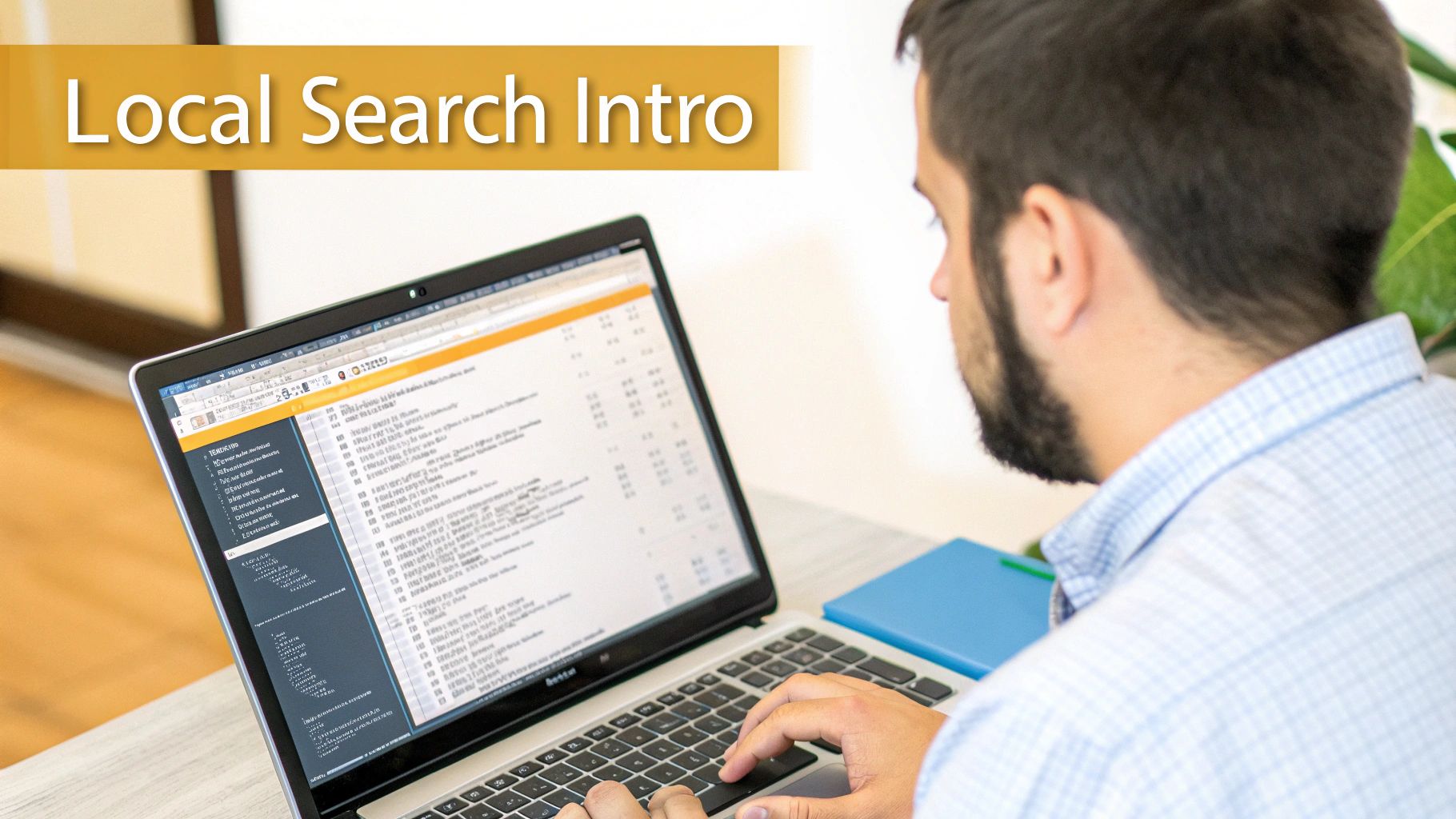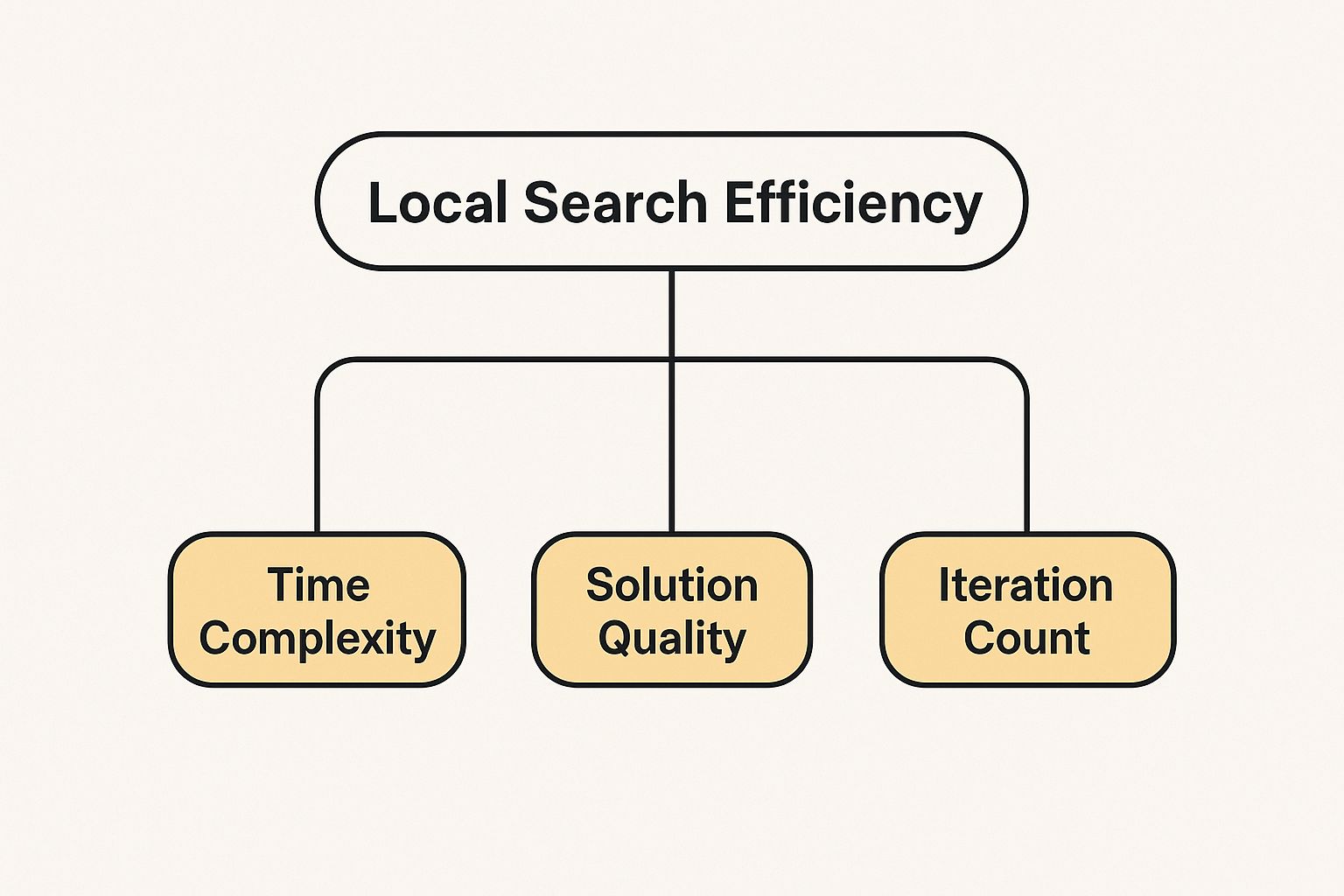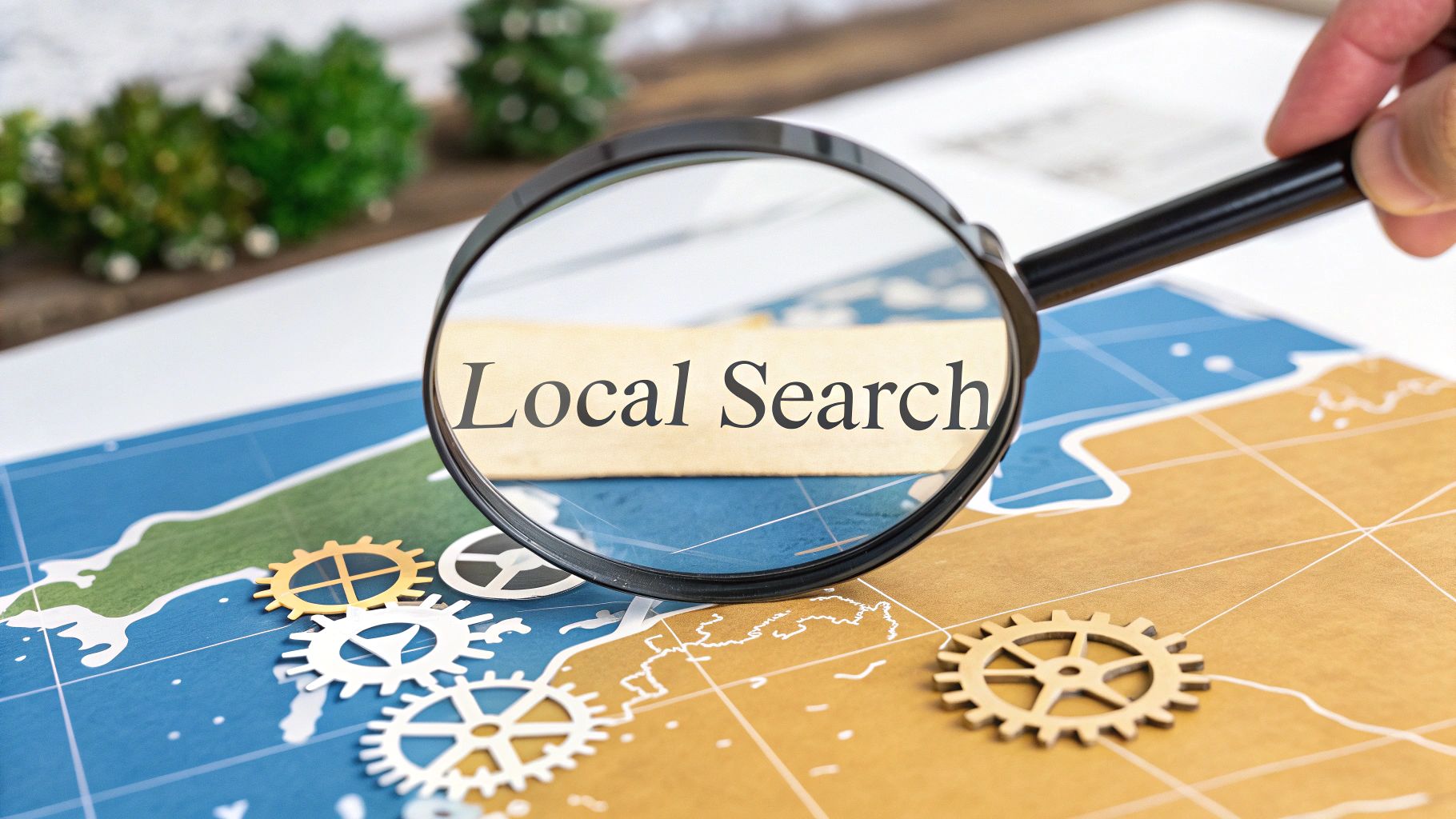A local search optimization algorithm is the complex system search engines like Google use to rank businesses for location-based searches, like "pizza near me." It's not one simple formula but a whole collection of signals that help Google figure out which local spots are the most relevant, well-known, and closest to the person searching. Getting a handle on this algorithm is how you land a spot in the coveted Local Pack and get seen on Google Maps.
How the Local Algorithm Actually Works

Let's pull back the curtain on the local search algorithm without getting bogged down in technical jargon. Think of it as the incredibly smart brain powering Google Maps. Its main job is to find the absolute best local business to solve whatever a user needs right now. It's not a rigid equation but a fluid system that weighs hundreds of different signals to make its call.
To simplify it, imagine you're asking a trusted, super-connected local friend for a recommendation. What would they consider? They'd probably think about three key things, which happen to mirror exactly how Google's algorithm thinks.
The Three Pillars of Local Search
The algorithm's entire decision-making process is built on three core pillars that work together to decide who shows up first.
- Relevance: Does your business actually offer what the person is looking for? The algorithm plays matchmaker, connecting a search query (like "emergency plumber") with your business category, the services you've listed, and the keywords on your website and Google Business Profile.
- Proximity: How close is your business to the searcher's physical location or the area they typed in? This one is pretty straightforward—actual, physical distance is a huge deal in local search.
- Prominence: How well-known and reputable is this business in the real world? The algorithm gauges this by looking at online reviews, local citations (mentions on directories like Yelp), links from local news sites or blogs, and your overall brand authority.
A common mistake is thinking proximity is the only thing that matters. While it's critical, a highly prominent and relevant business that's a bit farther away can absolutely outrank a closer, less-known competitor. Google is always trying to balance all three pillars to give people the most trustworthy results.
If you want to really get the principles behind how local algorithms work, it helps to first understand what Search Engine Optimization (SEO) is in a broader sense. That foundational knowledge gives you the context for all the specific tactics we use for local rankings.
At the end of the day, the local algorithm is designed to act like a real-world referral. It synthesizes all these digital signals to answer one question: "Which local business will give this person the best experience right now?" The more positive signals you send across these three pillars, the more likely the algorithm is to recommend you. This is why a complete, active online presence isn't just a nice-to-have anymore—it's the absolute foundation of local visibility. Grasping this "why" is the first step to making the algorithm work for you, not against you.
The Evolution of Local Search Ranking

To really get a grip on local SEO today, you have to understand where it came from. The local search algorithm wasn't born overnight. It started as a glorified digital phonebook and has since morphed into a sophisticated recommendation engine that tries to read a user's mind.
This isn't just a history lesson. It's the key to understanding why old-school tactics fall flat and how Google got so good at figuring out what people actually want when they search for something nearby. By seeing how the algorithm grew up, you get a much clearer picture of what really drives local rankings right now.
In the early days, local search was clunky. Proximity was everything. Rankings were basically a digital Yellow Pages—if your business was the closest, you had a great shot at the top spot, even if your website was terrible or your reputation was shaky.
The Pigeon Update Reshapes the Landscape
Then, in July 2014, everything changed. Google rolled out the Pigeon update, and it was a massive deal. For the first time, it forced local search results to play by the same rules as the main web search. Before Pigeon, the local and organic algorithms were practically two different games with separate rulebooks.
Pigeon recalibrated the entire local search optimization algorithm, tying it directly to Google's core web ranking signals. This meant factors like your website's domain authority, backlink profile, and on-page SEO suddenly became critical for local rankings. Proximity still mattered, but it was no longer the only thing on the scorecard. You can see how this fits into the bigger picture by exploring this detailed history of Google Search.
This update was the nail in the coffin for businesses that thought they could get by with just a Google listing and nothing else. It officially connected the dots: a strong website equals a better shot at ranking in the local map pack.
Pigeon’s real legacy was its obsession with quality. By roping local results into the main web algorithm, Google started rewarding businesses with strong, authoritative websites and pushing down those with weak or spammy online presences.
The Possum Update Hones Proximity and Filtering
A couple of years later, in 2016, another update called Possum came along and shook things up again. This one got into the nitty-gritty of physical location and business filtering—the kind of stuff Pigeon didn't fully address.
Possum made local results hyper-sensitive to the searcher's exact location. After the update, someone standing on one street corner could see a totally different set of results than someone just a few blocks away. It cranked up the dial on the importance of a user's immediate surroundings.
It also fixed a huge headache for businesses that were clustered together, like in the same office building. Google's old filters would often hide businesses that shared an address or category, showing just one. Possum loosened those filters, giving businesses in dense areas a much better chance to show up.
Key Takeaways from Local Algorithm Updates
Looking back at how the local search optimization algorithm has evolved, you see a clear pattern. Google is relentlessly trying to serve up results that aren't just close by, but are also the most relevant and trustworthy options.
Here's what this journey teaches us:
- Holistic SEO is Mandatory: You can't ignore your main website. Its health, content, and backlinks are now directly tied to your local map rankings.
- Proximity is Dynamic: It's not just about your address anymore. Where the user is physically standing when they search is now a massive factor.
- User Intent is Central: Google’s goal isn’t just to show the nearest business; it’s to give the searcher the best possible answer to their need.
Understanding this shift from a simple directory to a complex recommendation system is the secret to building a local SEO strategy that not only works today but is built to last.
Mastering the Three Pillars of Local Ranking
Google's local algorithm isn't some black box spitting out random results. It’s a decision-making framework built on three core pillars: Proximity, Relevance, and Prominence. Think of it like a three-legged stool—if one leg is wobbly, the whole thing gets unstable. To get a real handle on the local search optimization algorithm, you have to build strength across all three.
This isn't about finding a secret hack. It’s about building a balanced, authentic online presence that naturally signals to Google that your business is the best answer for someone searching nearby.
The chart below shows how different factors play into local search, balancing the complexity of the work with the quality of the result.

As you can see, hitting the top local ranks means you have to optimize a bunch of interconnected variables to get a high-quality, efficient outcome.
Pillar One: Proximity
At first glance, proximity seems simple: how close is your business to the person searching? While that's the gist of it, this pillar is way more dynamic than just a pin on a map. It’s not a fixed radius. It's a flexible boundary that shrinks or expands based on what the user is looking for.
For a high-stakes search like "emergency plumber near me," the algorithm will shrink that radius way down, prioritizing the absolute closest options available. But for a query like "best Italian restaurant," it might stretch the boundaries a bit, willing to show a highly-rated spot that’s a little further out.
Your physical address is the anchor, but the algorithm thinks about two main types of proximity:
- Explicit Location: This is when someone types a location right into their search, like "coffee shops in downtown Omaha."
- Implicit Location: This is based on the user's real-time device location, which is what powers all those "near me" searches.
The first step to optimizing for proximity is making sure your address is perfectly consistent everywhere online, starting with your Google Business Profile.
Pillar Two: Relevance
Relevance is basically Google’s matchmaking service. It’s laser-focused on one question: "Does this business actually offer what the user wants?" This goes way beyond just your business name.
Google is like a detective, piecing together clues from multiple sources. It scrutinizes your Google Business Profile categories, the services you list, the photos you upload, the keywords in your customer reviews, and the content on your website. If someone searches for a "pet-friendly cafe" and your GBP mentions a patio for dogs while customer reviews praise your "dog-friendly" vibe, you're sending incredibly powerful relevance signals.
Key Takeaway: Relevance is all about alignment. Every single piece of your digital footprint should consistently and clearly communicate what you do. Mismatched information or vague service descriptions just dilute these signals, making it harder for Google to confidently match you to a search.
For example, a local business can seriously boost its relevance by building out a targeted content strategy. If you're looking for practical ways to do this, our deep dive into local SEO in Omaha has actionable steps that work for any market.
Pillar Three: Prominence
Prominence is all about your business's authority and reputation, both online and in the real world. You can think of it as your local fame. How well-known are you? How much do people trust you? The algorithm tries to measure this by looking at a whole bunch of signals that paint a picture of your standing in the community.
This is honestly the toughest pillar to build because you can't fake it. It takes real, consistent effort over time.
To really nail local rankings, you need to understand how each of these pillars is supported by specific optimization tactics.
Key Signals for Local Ranking Pillars
This table breaks down the core signals and optimization tactics that feed into each of the three pillars. Think of it as a cheat sheet for where to focus your efforts.
| Pillar | Primary Signal | Key Optimization Tactics |
|---|---|---|
| Proximity | Physical address | Verify GBP address; ensure NAP consistency across all citations. |
| Relevance | Service & category alignment | Select specific GBP categories; use keywords in services, reviews, and website content. |
| Prominence | Authority & reputation | Earn high-quality reviews; build local citations and backlinks; generate positive brand mentions. |
By focusing on these specific tactics for each pillar, you create a well-rounded strategy that gives Google exactly what it’s looking for.
Building Real-World Authority Online
Prominence is a mix of several key factors that show you're a credible, trusted business.
1. Reviews: The number of reviews you have, their quality, and how frequently you get them are huge prominence signals. A steady stream of positive reviews tells Google that customers are consistently choosing and loving your business. It's also super important to respond to reviews—both good and bad—because it shows you're an engaged and accountable business owner.
2. Local Citations: These are mentions of your business's Name, Address, and Phone number (NAP) on other sites and directories like Yelp, Apple Maps, or industry-specific listings. Consistent NAP info across high-quality directories solidifies your location and legitimacy. Inconsistent data, on the other hand, creates confusion and weakens your authority.
3. Local Links: Getting backlinks from other well-respected local websites is like a vote of confidence. A link from a local news outlet, a neighborhood blog, or a community event page is a powerful signal. These links tell the algorithm that other local entities trust and vouch for you.
4. Brand Mentions: Even without a direct link, Google picks up on unlinked mentions of your brand name online. Positive chatter about your business on social media or in local forums all contributes to your overall prominence.
Ultimately, mastering these three pillars gives you a solid blueprint for success. By making sure your location data is precise (Proximity), your services are clearly defined (Relevance), and your reputation is strong (Prominence), you align your business directly with what the local search algorithm values most. This holistic approach is what separates the businesses that pop into the Local Pack once in a while from the ones that stay there.
Your Blueprint for a Winning Digital Footprint

Knowing the theory behind the local search optimization algorithm is one thing, but actually putting that knowledge to work is what separates the winners from the rest. This is where we stop talking about concepts and start taking concrete steps. The goal is to build a digital footprint so strong and clear that Google has zero doubt your business is the best answer for a local searcher.
Your journey starts with the single most important tool in your local SEO arsenal: your Google Business Profile (GBP). A mind-blowing 46% of all Google searches are for local information. For most of those people, your GBP is the first—and sometimes only—interaction they'll have with your brand.
It’s not just a listing; it’s a dynamic, interactive storefront on the world's biggest search engine. Getting it right isn't optional if you're serious about local search.
Transforming Your Google Business Profile
An unoptimized GBP is like having a "Closed" sign hanging on your shop door 24/7. To flip that sign to "Open for Business," you have to feed the algorithm rich, accurate, and engaging information.
Start with the absolute basics. Make sure your business name, address, phone number, and hours are filled out completely and are 100% correct. Accuracy and consistency here are the foundation everything else is built on.
From there, dial in on these high-impact areas:
- Strategic Category Selection: Don't just pick one broad category and call it a day. Choose a primary category that nails what you do, then pile on every relevant secondary category you can. This is how you tell Google about all the specific services you offer, widening the net for searches you can rank for.
- A Compelling Business Description: You get 750 characters—use them all. Write a description that’s packed with keywords but also speaks to actual human customers. What makes you different? What problems do you solve? What are you the best at?
- Consistent Visual Content: Regularly upload high-quality, geo-tagged photos and videos. We're talking pictures of your storefront, your team, your products, and your crew in action. Fresh visuals signal to Google that your business is active and gives customers a real peek inside.
By nailing these details, you're handing the algorithm the structured data it craves to confidently match you with the right customers.
Actively Engaging with GBP Features
A static profile is an invisible profile. The local algorithm loves activity and engagement. That means you need to be using the interactive features Google gives you to keep your listing fresh and alive.
Think of your GBP not as a static ad, but as a mini social media platform for your business. The more you post, interact, and update it, the more visible you become. This constant activity is a powerful signal of relevance and prominence.
Two of the most underused—and most powerful—features are Google Posts and the Q&A section.
- Google Posts: Use these to share updates, special offers, upcoming events, or new products directly on your profile. They show up right in the search results and prove your business is active. They expire after seven days, which is Google’s way of nudging you to post fresh content consistently.
- Q&A Section: Don't wait for customers to ask questions. Get in there and proactively ask and answer the most common questions about your business. This is a goldmine for providing helpful info and strategically weaving in important keywords. Be sure to monitor and answer any user-submitted questions quickly.
Using these features turns your profile from a boring directory listing into a valuable resource for both customers and Google's algorithm.
On-Page SEO for Local Dominance
Your GBP is critical, but your website is the other half of the puzzle. Your on-page SEO needs to shout the same local signals you’re sending through your GBP. This is where you build out location-specific service pages.
Instead of one generic "Services" page, create dedicated pages for each core service you offer in each main location you serve. A page titled "Residential Plumbing Repair in Omaha" sends a much stronger, more relevant signal than a catch-all page. If you're looking for a clear roadmap, exploring professional local SEO services can show you exactly how to structure your site for maximum impact.
Each of these pages should be optimized with local keywords, unique content that's actually useful, customer testimonials, and a clear call-to-action. To take it a step further, personalizing content is key. For those running paid campaigns, it's also smart to learn how to insert dynamic location on your Google Ads landing pages for a seamless user experience.
Finally, you need to implement local schema markup on your website. This is just a bit of code that speaks directly to search engines in their native language. It explicitly defines your business name, address, phone number, and hours, removing any possible confusion. It helps the algorithm process your info with perfect accuracy, cementing your digital footprint.
Why User Behavior and Reviews Are Your Secret Weapon
The local search algorithm is smarter than just reading your business details; it’s actively watching how real people interact with your online presence. Think of it like Google running a city-wide popularity contest. When people consistently engage with your profile, it sends a massive signal that your business is a top choice in the community.
These user engagement signals are basically digital proof that people are interested in what you offer. Every time someone clicks to call your shop, asks for driving directions from your Google Business Profile, or clicks through to your website, it's a vote of confidence. The algorithm logs every single one of these interactions, using them as key indicators of your real-world relevance.
The True Power of Online Reviews
While clicks and calls are great, nothing tells the story of your business quite like online reviews. They are, without a doubt, the most powerful form of social proof in local search. But here’s where a lot of business owners get it wrong: it’s not just about chasing a perfect five-star rating. The algorithm looks much, much deeper than that.
What really moves the needle is the complete picture of your review profile. This means looking at a few key factors that together paint a full picture of customer sentiment and how your reputation holds up over time.
A steady stream of four-star reviews is often more valuable to the algorithm than a handful of perfect five-star reviews from a year ago. Consistency and recency show that your business is maintaining quality service right now.
This isn't a new trend. Google’s algorithm has been moving this way for years, trying to better understand what people actually want. Between 2013 and 2016, major updates like Hummingbird shifted the focus from simple keywords to understanding context, making authentic user feedback more important than ever. You can learn more about how these historical updates shaped modern SEO.
Building a System for Positive Feedback
To turn happy customers into a real ranking advantage, you need a repeatable system for generating reviews. This isn't about being pushy; it's about making it incredibly easy for satisfied customers to share their experience.
An effective review strategy really comes down to three things:
- Review Velocity: This is just a fancy way of saying the speed at which you get new reviews. A consistent flow of fresh feedback signals that your business is active and popular right now.
- Keyword-Rich Language: The algorithm actually reads the text inside reviews. When customers naturally use phrases like "best deep dish pizza in Omaha" or "fast and reliable plumbing service," it powerfully reinforces your relevance for those searches.
- Owner Responses: How you respond to feedback is a direct signal to both potential customers and Google. Promptly thanking positive reviewers and professionally addressing negative comments shows you’re an engaged, accountable business owner.
Handling negative reviews the right way is especially critical. A thoughtful response that offers a solution can build trust and show your commitment to customer service, often turning a negative into a net positive. Ignoring them? That’s a major red flag for everyone.
At the end of the day, a strong review profile built on authentic feedback and active engagement is your most powerful weapon for climbing the local search rankings.
Your Local Search Questions, Answered
Even after you get a handle on the core strategies, the local search optimization algorithm can feel like a bit of a black box. You’re doing the work, but you’ve still got practical, nagging questions about what to expect and where you should really be putting your energy.
This is where we clear things up. We're going to tackle the real-world questions that leave most business owners guessing. From timelines to ranking outside your ZIP code, let’s get you some straight answers.
How Long Does Local SEO Take to Work?
This is probably the number one question we get, and the honest answer is: it depends. Patience is key here, but you can generally expect to see some real traction within three to six months of consistent, focused work. Your market’s competitiveness and where you’re starting from will make a big difference in that timeline.
Some wins come quickly. If you just claim and fully optimize your Google Business Profile with sharp photos and dead-on accurate info, you might see a bump in a few weeks. But the stuff that really builds a lasting presence—earning great reviews, getting quality backlinks, and building consistent citations—that’s a long game. It’s better to think of local SEO as an ongoing investment, not a one-and-done project with instant results.
Can I Rank in a City Where I Don't Have a Physical Address?
It's a common goal for service-area businesses, but it's a tough one. Ranking in the Local Pack for a city where you don't have a verified physical address is extremely difficult, and for good reason—it goes against the grain of how Google's algorithm is designed to work. The whole system is built on proximity, so it will almost always favor businesses that are physically right there.
You can definitely build out location-specific pages on your website to show up in the traditional organic results for nearby cities. But getting on the map itself without a real local address? That's a whole different ballgame and nearly impossible to pull off legitimately.
Trying to game the system with a virtual office, a P.O. box, or a shared workspace is a risky move. These tactics violate Google's guidelines and can get your Google Business Profile suspended, wiping out all your hard work in an instant.
Your best bet is to completely dominate the area where you are physically located. Once you've built a rock-solid foundation of prominence and relevance there, you can expand your reach by creating website content that targets surrounding areas for the organic search results below the map pack.
Do Negative Reviews Actually Hurt My Ranking?
Every business owner has that moment of dread when a one-star review pops up. Here’s the good news: a few bad reviews won’t tank your rankings, especially if you have a steady stream of positive ones coming in. The local search optimization algorithm doesn't just look at isolated incidents; it looks at your entire review profile.
Here’s what the algorithm really cares about when it comes to reviews:
- Overall Average Rating: Your total score across all reviews.
- Review Velocity: How often you’re getting new reviews (this signals you're still popular).
- Review Engagement: Whether you, the owner, are actually responding to people.
In fact, responding professionally to a negative review can be a positive signal. It shows Google (and potential customers) that you’re an engaged business owner who cares about the customer experience. The real danger is in letting negative feedback pile up without a response or having your profile completely dominated by unhappy customers. That’s what kills trust and hurts the positive signals the algorithm wants to see. A healthy mix, with a strong positive trend and active owner engagement, is exactly what you’re aiming for.
Ready to stop guessing and start dominating your local market? The team at Up North Media uses data-driven strategies to make the local search algorithm work for you. Let's build a powerful digital footprint that drives real growth. Schedule your free consultation with Up North Media today!
